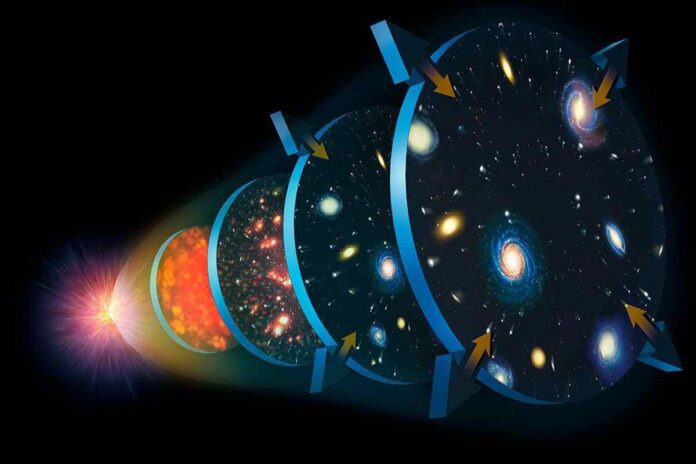Early universe observations by the James Webb Space Telescope (JWST) cannot be explained by current cosmological models. These models estimate the universe to be 13.8 billion years in age, based on the big-bang expanding universe concept.
My research proposes a model that determines the universe’s age to be 26.7 billion years, which accounts for the JWST’s “impossible early galaxy” observations.
Impossible early galaxies refer to the fact that some galaxies dating to the cosmic dawn—500 to 800 million years after the big bang—have disks and bulges similar to those which have passed through a long period of evolution. And smaller in size galaxies are apparently more massive than larger ones, which is quite the opposite of expectation.
Frequency and distance
This age estimate is derived from the universe’s expansion rate by measuring the redshift of spectral lines in the light emitted by distant galaxies. An earlier explanation of the redshift was based on the hypothesis that light loses energy as it travels cosmic distances. This “tired light” explanation was rejected as it could not explain many observations.
The redshift of light is similar to the Doppler effect on sound: noises appear to have higher frequency (pitch) when approaching, and lower when receding. Redshift, a lower light frequency, indicates when an object is receding from us; the larger the galaxy distance, the higher the recessional speed and redshift.
An alternative explanation for the redshift was due to the Doppler effect: Distant galaxies are receding from us at speeds proportional to their distance, indicating that the universe is expanding. The expanding universe model became favored by most astronomers after two astronomers working for Bell Labs, Arno Penzias and Robert Wilson, accidentally discovered cosmic microwave background (CMB) radiation in 1964, which the steady-state model could not satisfactorily explain.
The rate of expansion essentially determines the age of the universe. Until the launch of the Hubble Space Telescope in the 1990s, uncertainty in the expansion rate estimated the universe’s age ranging from seven to 20 billion years. Other observations led to the currently accepted value of 13.8 billion years, putting the big-bang model on the cosmology pedestal.
Limitations of previous models
Research published last year proposed to resolve the impossible early galaxy problem using the tired light model. However, tired light cannot satisfactorily explain other cosmological observations like supernovae redshifts and uniformity of the cosmic microwave background.
I attempted to combine the standard big-bang model with the tired light model to see how it fits the supernovae data and the JWST data, but it did not fit the latter well. It did, however, increase the universe’s age to 19.3 billion years.
Next, I tried creating a hybrid model comprising the tired light and a cosmological model I had developed based on the evolving coupling constants proposed by British physicist Paul Dirac in 1937. This fitted both the data well, but almost doubled the universe’s age.
The new model stretches galaxy formation time 10 to 20 fold over the standard model, giving enough time for the formation of well-evolved “impossible” early galaxies as observed.
As with any model, it will need to provide a satisfactory explanation for all those observations that are satisfied by the standard cosmological model.
Mixing models
The approach of mixing two models to explain new observations is not new. Isaac Newton considered that light propagates as particles in his theory of light, which prevailed until it was replaced by the wave theory of light in the 19th century to explain diffraction patterns observed with monochromatic light.
Albert Einstein resurrected the particle-like nature of light to explain the photoelectric effect—that light has dual characteristics: particle-like in some observations and wave-like in others. It has since become well-established that all particles have such dual characteristics.
Another way of measuring the age of the universe is to estimate the age of stars in globular clusters in our own galaxy—the Milky Way. Globular clusters include up to a million stars, all of which appear to have formed at the same time in the early universe.
Assuming all galaxies and clusters started to form simultaneously, the age of the oldest star in the cluster should provide the age of the universe (less the time when the galaxies began to form). For some stars such as Methuselah, believed to be oldest in the galaxy, astrophysical modeling yields an age greater than the age of the universe determined using the standard model, which is impossible.
Einstein believed that the universe is the same observed from any point at any time—homogeneous, isotropic and timeless. To explain the observed redshift of distant galaxies in such a steady-state universe, which appeared to increase in proportion to their distance (Hubble’s law), Swiss astronomer Fritz Zwicky, proposed the tired light theory in 1929.
New information
While some Hubble Space Telescope observations did point towards the impossible early galaxy problem, it was not until the launch of JWST in December 2021, and the data it provided since mid-2022, that this problem was firmly established.
To defend the standard big-bang model, astronomers have tried to resolve the problem by compressing the timeline for forming massive stars and primordial black holes accreting mass at unphysically high rates.
However, a consensus is developing towards new physics to explain these JWST observations.
Provided by The Conversation
This article is republished from The Conversation under a Creative Commons license. Read the original article.

Hi Rajendra,
Further theorisation beyond the standard model is certainly needed and your proposal provides food for thought. You suggest a revised estimated age of the universe to be 26.7bn years. However, you say your model stretches galaxy formation time 10 to 20 fold beyond the current estimate, which would give an age range of 138bn to 276bn years, way over your figure of 26.7bn years. Clarification would be appreciated?